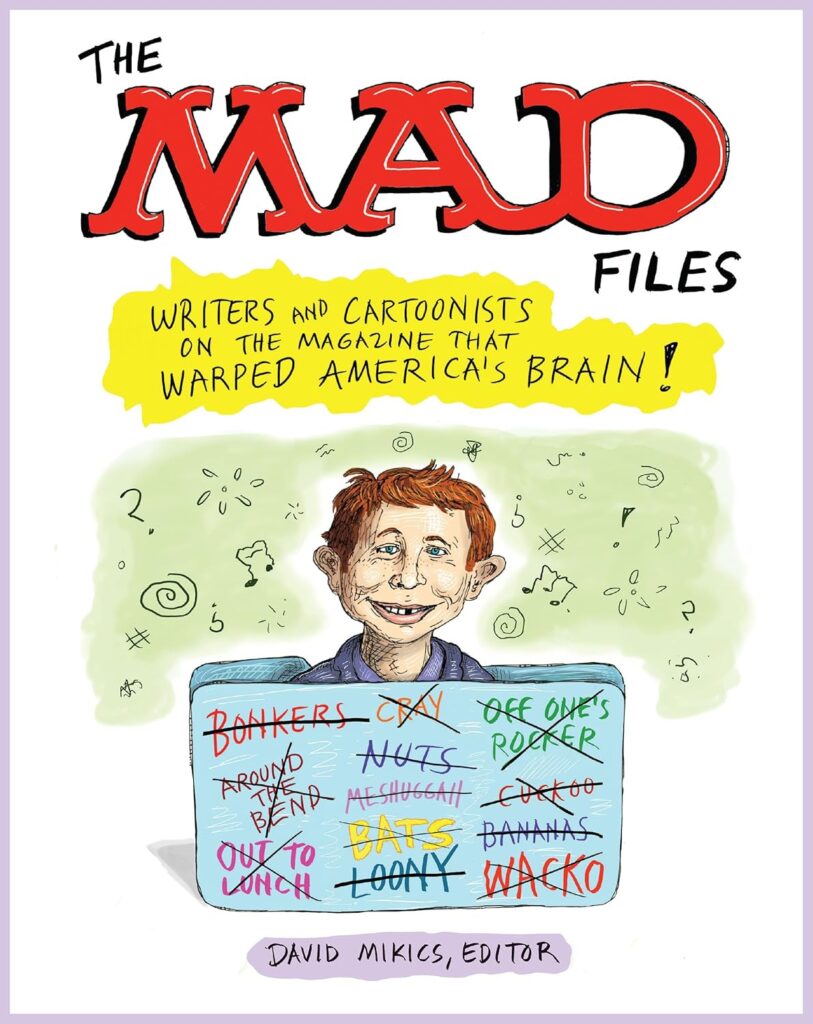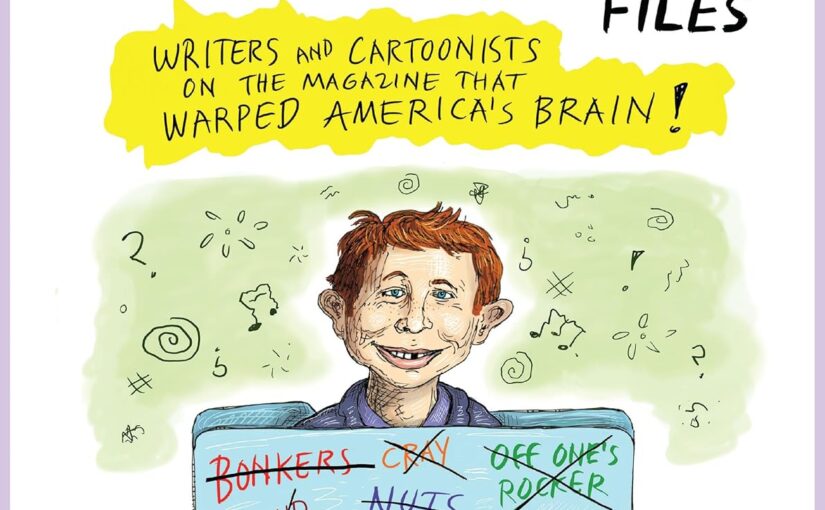I bought a Mad Magazine at our local comic book store a couple of years ago. As a teenager, back in the early-to-mid 80’s, I read Mad Magazine quite often. My friends and I would sleep over, share our monthly copies, bring the Mad paperback books we’d collected, read silently and occasionally repeat one of the jokes aloud. My favorite flip-flopped between the art by Sergio Aragones, Spy Vs. Spy, and the Snappy Answers to Stupid Questions segments. If The Mad Files: Writers and Cartoonists on the Magazine that Warped America’s Brain! had a song that played along while you were reading it would be Little River Band and Reminiscing.

That would just be the bumper music, for the first 20 or 30 seconds into reading The Mad Files. After that the essays about the magazine’s creation take over the driver’s seat. People of a certain age had their sense of humor primed and crafted by Mad Magazine and the Usual Gang of Idiots. The monthly results were a dish that came from the kitchen with a handful of different chefs, but always had the same result when you consumed it. It was funny, it was weird, it was irreverent and it mocked the entertainment that either deserved being filleted or was blissfully unaware of its stupidity.
The Mad Files is made up of 25 essays by authors, columnists, thinkers or cartoonists who grew up with Mad Magazine. Essays are something that you last encountered in college. It could be more appropriate to call these a stream-of-consciousness writings that are smart, makes you think, and allows you to remember the finer points of the magazine, as well as, those aspects that you didn’t remember or didn’t appreciate. This is a book whose audience immediately recalls the times that they saw Alfred E. Neuman and his gap-toothed smile asking people “what me, worry?”, as he was doing something carefree or otherwise stupid.
The essays in The Mad Files and the way they reminisce about when the respective writers first encountered Mad Magazine will feel familiar. That was when I first discovered Mad Magazine. It was at my cousin’s house when we’d read Mad Magazine and try to figure out those words that I discovered what was funny. It was subversive, a funny kind of subversion that my parents said that they didn’t approve of, but would probably laugh at if they gave the magazine a chance. And since I’m the age of my parents, to the kid I was then, and can laugh at the vintage issues; regardless of whom or what was being parodied on the cover, I can attest that those young readers who thought that were correct.
The Mad Files digs into the history of the magazine by virtue of the stories that track its creators from EC Comics, how it was a comic book-but changed to a magazine, the war comics that some of the talent worked at, and the Jewish roots of many of the legendary artists. These are stories that the casual fan probably doesn’t know, but will make sense once your brain’s muscle memory kicks in and Mort Drucker’s realistic, exaggerated comes back to your adult thoughts and “yech” is something you’ll start saying as an adjective.
I did enjoy the individual essays, but you do need a break from reading them. This is especially true for the first five or six of them because their tone and structure were similar. It’s not the same as a bathroom book break, because each essay will take about 12 minutes to read. That amount of time is too long for a book in the loo, but reading more than two essays in a row might them seem routine. And cultural subversion, especially the level of satire and pointed or obscure humor that one sees in an issue of Mad Magazine shouldn’t seem ordinary.
When Mad Magazine was at its peak there were no other avenues for that kind of humor. It paved the road for Cracked, Crazy, National Lampoon, Saturday Night Live, The Onion, Babylon Bee and any other vehicle whose goal was to make people laugh, albeit via slightly twisted humor. It embraced the movies, shows or music of the moment and skewered them in a way that was the currency of a 12-year-old’s entertainment that we didn’t fully understand. It was that misunderstood aspect that made Mad Magazine timeless. There were cultural jokes we didn’t get, language barriers that were broken (but we didn’t understand) and entertainment we were aware of, but hadn’t seen or snuck into yet.
The Mad Files reminds adult readers of what we enjoyed when it was happening. There are some things that we enjoy or take part in, but don’t fully appreciate when they’re around, like seeing Rush in concert. To that end, even Power Windows, when you listen to it now, is appreciated, very enjoyable and makes you wish that you had enjoyed it more when it first came out. With The Mad Files you’ll read about others enjoying something that you did also. They’ll pick out different things that they liked, remind you of the things that you forgot about, tell you something that you didn’t know about the magazine’s creation and make you smile as you reminisce.
The Mad Files: Writers and Cartoonists on the Magazine that Warped America’s Brain!: A Library of America Special Publication is edited by David Mikies and available from Library of America.
There are affiliate links in this post.





 Facebook
Facebook Twitter
Twitter Flickr
Flickr GooglePlus
GooglePlus Youtube
Youtube